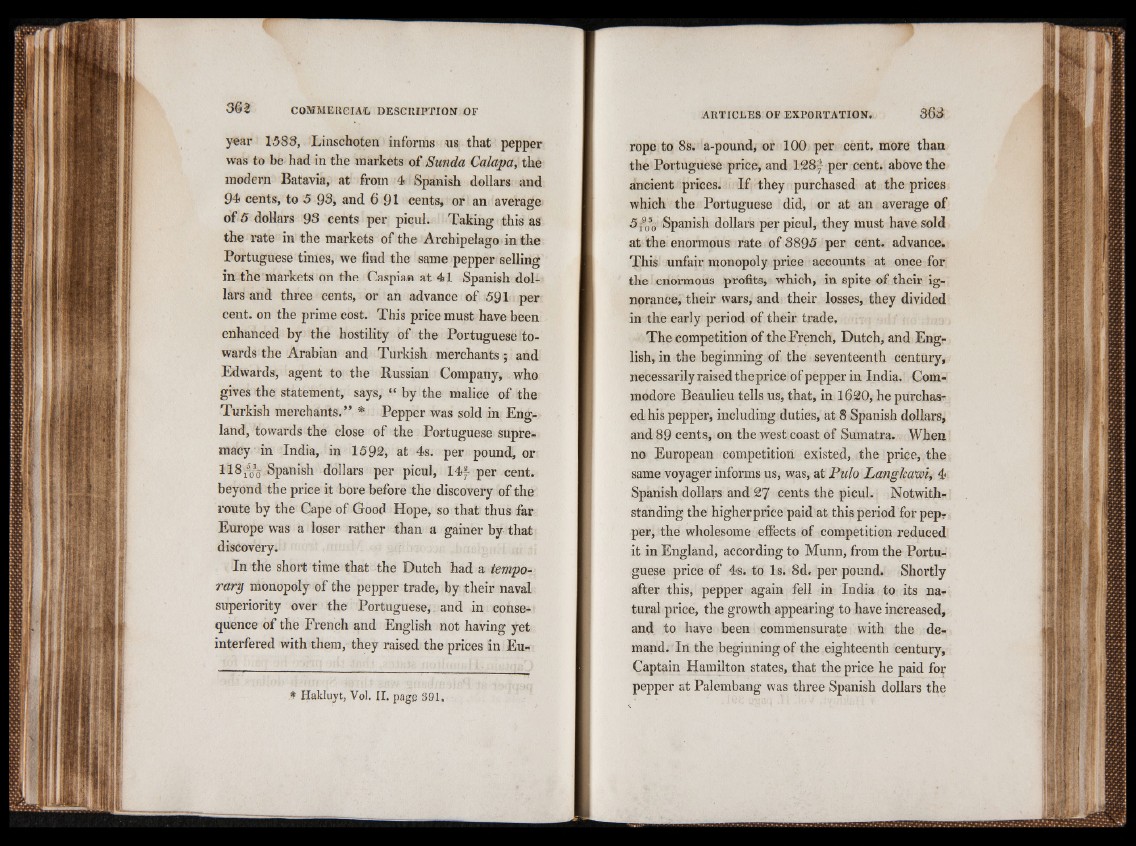
year 1583, Linschoten informs us that pepper
was to be had in the markets of Sunda Calapa, the
modern Batavia, at from 4 Spanish dollars and
94 cents, to 5 93, and 6 91 cents, or an average
of 5 dollars 93 cents per picul. Taking this as
the rate in the markets of the Archipelago in the
Portuguese times, we find the same pepper selling
in the markets on the Caspian at 41 Spanish dollars
and three cents, or an advance of 591 per
cent, on the prime cost. This price must have been
enhanced by the hostility of the Portuguese towards
the Arabian and Turkish merchants; and
Edwards, agent to the Russian Company, who
gives the statement, says, “ by the malice of the
Turkish merchants.” * Pepper was sold in England,
towards the close of the Portuguese supremacy
in India, in 1592, at 4s. per pound, or
llS ^o Spanish dollars per picul, 14f per cent,
beyond the price it bore before the discovery of the
route by the Cape of Good Hope, so that thus far
Europe was a loser rather than a gainer by that
discovery.
In the short time that the Dutch had a temporary
monopoly of the pepper trade, by their naval
superiority over the Portuguese, and in consequence
of the French and English not having yet
interfered with them, they raised the prices in Eu
♦ Hakluyt, Vol. II. pagg 391.
rope to 8s. a-pound, or 100 per cent, more than
the Portuguese price, and 128| per cent, above the
ancient prices. If they purchased at the prices
which the Portuguese did, or at an average of
Spanish dollars per picul, they must have sold
at the enormous rate of 3895 per cent, advance.
This unfair monopoly price accounts at once for
the enormous profits, which, in spite of their ignorance,
their wars, and their losses, they divided
in the early period of their trade,
The competition of the French, Dutch, and Engr
lish, in the beginning of the seventeenth century,
necessarily raised the price of pepper in India. Commodore
Beaulieu tells us, that, in 1620, he purchasr
ed his pepper, including duties, at 8 Spanish dollars,
and 89 cents, on the west coast of Sumatra. When
no European competition existed, the price, the
same voyager informs us, was, at Pulo Langhatsui, 4
Spanish dollars and 27 cents the picul. Notwithstanding
the higherprice paid at this period for pep?
per, the wholesome effects of competition reduced
it in England, according to Munn, from the Portuguese
price of 4s. to Is. 8d. per pound. Shortly
after this, pepper again fell in India to its natural
price, the growth appearing to have increased,
and to have been commensurate with the demand.
In the beginning of the eighteenth century,
Captain Hamilton states, that the price he paid for
pepper at Palembang was three Spanish dollars the